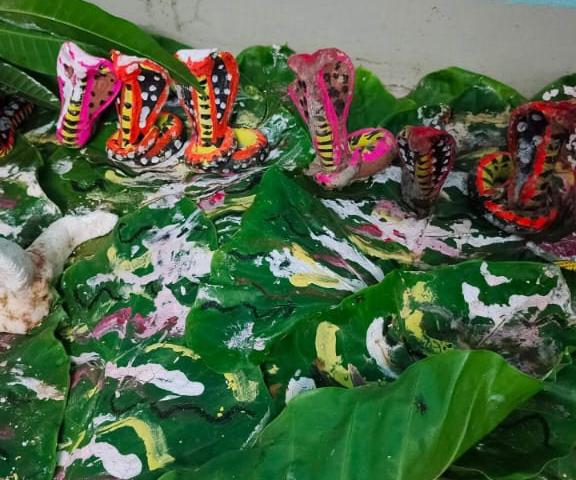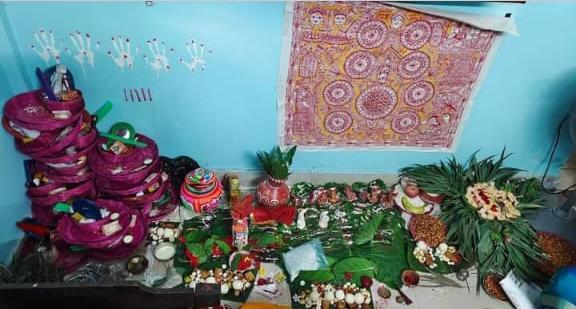India is full of rich cultural heritage; every region has its festivals to celebrate, which have been rooted in their psyche for centuries. Mithila region of Bihar also celebrates a festival in the month of Sawan known as Madhushravani. Apart from Bihar, it is celebrated in some regions of Uttar Pradesh, Bengal and Northern India. This is also celebrated in the Madhesh Province of the neighbouring country Nepal. The whole region of Mithila is full of vibrant colours and the fragrance of flowers is in the air. The festival starts from the fifth day of krishna paksha of Saavan month and is celebrated for 15 days of the month till the third day of Shukla paksha of Saavan. It marks the beginning of the monsoon season. Madhu means “Honey”, which symbolises sweetness, and Shravani means “Of Saavan” Therefore, Madhushravani means the festival which celebrates the Sweetness of Saavan among newlywed couples and rejoices in their life. This is celebrated by the newlywed brides of the brahmin, kayastha and sonar families who keep fast for 14 days for their husband’s well-being and long age.
Mythology Associated with Festival
The festival has mythology related to Shiva, Parvati and their snake daughters. There are many legends behind the festivals. According to one story, once Shiva and Parvati were playing in the water in deep love and he placed his semen on the five lotuses which later took birth as five Naag kanyas. Shiva often used to play with them and was once caught by Parvati. Seeing all this Parvati came into rage and then Shiva revealed the truth to her. According to another version, his daughters were born when Shiva was having a bath in Sonada Lake, and his five strands of hair fell into the water, forming five lotuses. At the request of Shiva, these girls took the form of five Naag Kanyas: Jaya Bishhari, Dhothila Bhawani, Padmavathi, Mayna Bishari and Mansa Bishari. Yet another story narrates that of a devout wife, Behula, who saves her husband from the bite of these naga kanyas by rafting to heaven. Since then these naga kanyas, the daughters of Shiva are revered and worshipped. All these stories are the main theme of the “Manjusha Paintings” practised in the Angika region of Bihar. On The occasion of Madhushravani, deities such as Shiva, Parvati, Nagas, Sun, Moon and Navgrahas are worshipped. All 14 days have different stories to narrate such as Samudra Manthan, Shiv Parvati Vivaah, Birth of Shiva’s children, Ganga Avtaran and many more. After each story “Baacho Binni’ is recited. The whole region then celebrates Nachari folk songs.

Purainic Patta, Jhilmil Latta, Taahi Chadhhi Baishli Bishahari Maata . Haath Supaari Khoincha Paan, Bishahari Maata Karti Subha Kalyaan
The Above lines are Baacho Binni: Goddess Baishli Bishahari, seated on the lotus leaf-like shimmering creepers. She has a betel nut in her hand and Paan in her Saari will do all good.
Rituals Associated with Madhushravani
On the first day at the bride’s house, she cleans, bathes, and prepares the Gonsai Ghar/Kohbar Ghar where the Madhushravani is being performed. In the afternoon she goes with her friends to pluck the flowers and leaves from the garden. Flowers such as Jahi, Juhi, Agar, Kusum, Tagar, Maina, Mehndi and many seasonal flowers are plucked. These leaves and flowers decorate the daala made up of Bamboo. After that in place of the puja, Airpan with pithaar (Rice paste) is made with the festival symbols. In the night Gauri is prepared by grinding different materials. Later, four leaves of Maina are kept and serpents are made using Pithaar, Mehndi, Chandan, Kaajal and Sindoor. The next day, she is adorned with Solah Sringara and the puja is performed from the materials given from the house of her in-laws and the ritual is performed with the help of Bidhkari. She does the puja, later offers the flowers to the deities and has Arva Bhojan sent from her house of in-laws. The same rituals are performed for 13 days. On the last day before Madhushravani, Visarjan is done. On the day of Madhushravani, the groom should be present there and his parichhan is done. After the puja, the groom puts sindoor on his bride for the third time.

Temi Ritual
After all the rituals, Temi is done. Temi is burning the feet and knees of the bride with the help of cotton baati dipped in ghee. It is believed that the bigger the burn gets, the husband would have more longevity. Some believe that no burn mark on her knees and feet justifies that the girl was not married earlier. Others believe these burn marks will help the bride be more tolerant towards her domestic life. Nowadays this practice is changed and is converted to Sheetal-Temi, where the baati is put off and is touched to the knees and feet, or it is just brought close to it only and does not burn the bride. Despite baati, nowadays the circle is made on the knees and feet using red chandan. This suggests that the culture and rituals can be rechecked and reformed in a new way and the importance of festivals is also maintained.
Significance
All the festivals have its significance and are important from the historical and cultural point of view. Madhushravani festival also cherishes its mythological relation with the deities and nature. It celebrates the greenery of the month of shravan with seasonal plants and flowers and promotes awareness of the region’s snakes. It cherishes the beautiful relationship between humans, animals and nature. Apart from all this, it celebrates the union and love among the newlywed couples which helps them to know each other’s responsibility towards each other.